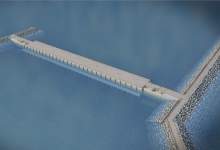

Discover B2B Marketing That Performs
Combine business intelligence and editorial excellence to reach engaged professionals across 36 leading media platforms.
Planners for an ambitious tidal wave project proposed in Swansea, Wales, which hopes to generate renewable electricity for more than 120,000 homes for up to 120 years, have presented the findings from its Environmental Impact Assessment (EIA) revealing it would have a ‘minor but mitigable’ effects.
Head of planning for the Tidal Lagoon Swansea Bay project Alex Herbert said, at an event held in Swansea’s Liberty Stadium, he recognised that a major infrastructure project of this size will inevitably cause some environmental impact, but the company has sought to minimise this in all aspects of the project’s design.
"Potential effects during construction, operation and decommissioning phases are limited in magnitude and predominantly contained to Swansea Bay itself," he added.

US Tariffs are shifting - will you react or anticipate?
Don’t let policy changes catch you off guard. Stay proactive with real-time data and expert analysis.
By GlobalDataThe epic £550m project will be the world’s first man-made energy-generating lagoon, with a 240MW nominal rated capacity averaging 14 hours of generation every day.
It is an alternative to a proposed £25bn barrage from Wales to Bristol, which has come up against opposition from the UK Government who said in July it could not approve the plan, because it was not economically viable without heavy subsidies. Bristol, in England, is also opposed to the plan due to environmental considerations.
Maximising the potential of existing turbine technology
Utilising the Severn Estuary’s 8.5 metre tidal range, which is the second highest in the world, the Tidal Lagoon Swansea Bay project proposes creating renewable electricity using existing turbine technology.
Electricity will be generated when water flows through the turbine blades as the tide goes in and then also when it goes out – allowing four windows every 24 hours for the blades to operate at peak capacity.
The turbines will have a runner diameter in the region of seven metres and be permanently submerged below the low water level in Swansea Bay.
This lagoon would help increase the amount of electricity the UK gets from renewable energy, which currently is only five percent.
The EIA revealed some of the potential impacts the project could have on local beaches and water quality, but overall Bernard Ainsworth, a member of Tidal Lagoon Swansea Bay’s construction board, said they would be ‘minor and mitigable’.
Some of the effects include an increased tidal speed between the lagoon and an area of the bay called Mumbles, effects to the pattern of sand transportation in the bay and wave height at Mumbles could be increased by almost 20 inches in a "worst case scenario". However, the effect on water quality was said to be ‘benign’.
The project, which is currently looking to raise up to £5m of qualifying Enterprise Investment Scheme (EIS) and £5m of non-EIS qualifying shares, also plans to be a community hub with an education centre, to hold annual sporting events which would take place around the lagoon.
Tidal Lagoon (Swansea Bay) plc will enter their application for approval on the 6 December. If approved, the project planners have earmarked 2017 as their deadline for getting electricity to the grid. So far the project hasn’t received any serious opposition. Once the application is submitted an answer is expected to be given by 2015.
Related content
The Sahara Forest Project – from the industrial to the ecological age
The Sahara Forest Project in Qatar exploits abundant sea water to produce electricity and grow fresh crops using a synergy of technologies.
Top 10 biggest offshore wind farms
The UK hosts seven of the world’s biggest offshore wind farms, while Denmark and Belgium round out the top 10.


.gif)



